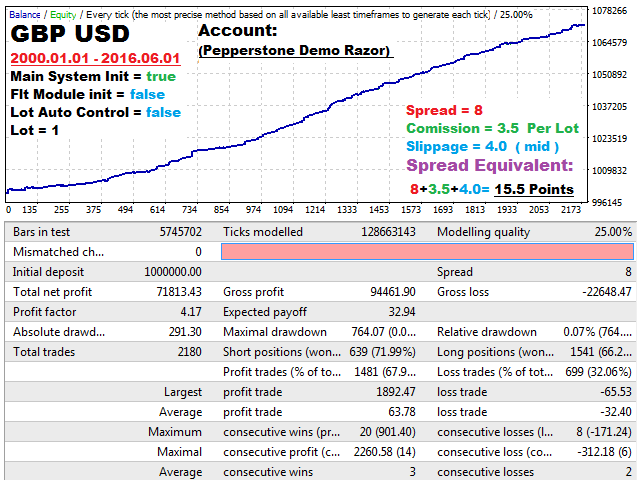Evgeniy Ilin / Profil
- Informations
|
8+ années
expérience
|
4
produits
|
1043
versions de démo
|
|
0
offres d’emploi
|
0
signaux
|
0
les abonnés
|
Les paramètres pour mes conseillers Neon Trade et Neon Shadow sont mis à jour quotidiennement ici : https://t.me/Centropolis_Lights
Le meilleur courtier pour mes conseillers https://clck.ru/39fLmk
ChatGPT 4.0, MidJorney 5, Dall-e, et d'autres réseaux neuronaux dans notre bot Telegram : htt

Dans cet article, j'ai décidé de mettre en avant le célèbre schéma de Bernoulli et de montrer comment il peut être utilisé pour décrire des tableaux de données liées au trading. Tous ces éléments seront ensuite utilisés pour créer un système de trading auto-adaptatif. Nous chercherons également un algorithme plus générique, dont un cas particulier est la formule de Bernoulli, et nous lui trouverons une application.

Le développement de modèles mathématiques multifonctionnels pour les tâches de trading constituerait une suite logique du sujet abordé précédemment. Dans cet article, je décrirai l'ensemble du processus lié au développement du premier modèle mathématique décrivant les fractales, en partant de zéro. Ce modèle devrait devenir un élément de base important et être multifonctionnel et universel. Il permettra d'établir notre base théorique pour le développement ultérieur de cette idée.

Dans cet article, nous poursuivrons l'étude des fractales et nous nous attacherons à résumer l'ensemble du matériel. Pour ce faire, j'essaierai de rassembler tous les développements antérieurs sous une forme compacte, pratique et compréhensible pour une application pratique dans le domaine du trading.

Dans cette série d'articles, nous tenterons de trouver une application pratique de la théorie des probabilités pour décrire les processus de trading et de fixation des prix. Dans le premier article, nous examinerons les bases de la combinatoire et des probabilités, et nous analyserons le premier exemple d'application des fractales dans le cadre de la théorie des probabilités.

Cet article est le premier d'une série consacrée aux figures (ou motifs, modèles, patterns) d'inversion dans le cadre du trading algorithmique. Nous commencerons par la famille de modèles la plus intéressante, qui trouve son origine dans les modèles Double Top et Double Bottom.

Dans cet article, j'essaierai d'élargir le concept classique des méthodes de trading par swap. J'expliquerai pourquoi je suis arrivé à la conclusion que ce concept mérite une attention particulière et qu'il est absolument recommandé de l'étudier.

The article presents an improved brute force version, based on the goals set in the previous article. I will try to cover this topic as broadly as possible using Expert Advisors with settings obtained using this method. A new program version is attached to this article.

In this article I will demonstrate some very interesting and useful techniques for automated trading. Some of them may be familiar to you. I will try to cover the most interesting methods and will explain why they are worth using. Furthermore, I will show what these techniques are apt to in practice. We will create Expert Advisors and test all the described techniques using historic quotes.

This article provides a continuation to the brute force topic, and it introduces new opportunities for market analysis into the program algorithm, thereby accelerating the speed of analysis and improving the quality of results. New additions enable the highest-quality view of global patterns within this approach.

Dans cet article, j'essaierai de vérifier l'hypothèse selon laquelle tout système ayant une compréhension, même limitée, du marché peut fonctionner à l'échelle mondiale. Je n'inventerai pas de théories ou de modèles, mais j'utiliserai uniquement des faits connus, que je traduirai progressivement dans le langage de l'analyse mathématique.

In this article we will continue discussing the brute force approach. I will try to provide a better explanation of the pattern using the new improved version of my application. I will also try to find the difference in stability using different time intervals and timeframes.

In this article, I will show the criteria to be used when selecting a system or a signal for investing your funds, as well as describe the optimal approach to the development of trading systems and highlight the importance of this matter in Forex trading.

In this article, I will try to explain in detail what grid and martingale are, as well as what they have in common. Besides, I will try to analyze how viable these strategies really are. The article features mathematical and practical sections.
I tried easy_grid on Demo it's good. can you insert ea for trailing SL code, so we can make our profit lock. and when Bid price above highest buy price + some point and all trade are in profit then it's reverse and our profitable trade are in loss. as well as when Ask below lowest sell price - some point it should be close all sell profitable trade. so this Expert can be more profitable. you can try change code and make it More profitable.
and second thing is that you can try for sell stop trade from Past Higher High to lowest low and vise versa for Buy stop from Past lowest low to Past Higher High. This is my thought if you can change it and try it and test it. Thanks

In this article, we will search for market patterns, create Expert Advisors based on the identified patterns, and check how long these patterns remain valid, if they ever retain their validity.

The article aims to describe the main features of Forex trading as simply and quickly as possible, as well as share some basic ideas with beginners. It also attempts to answer the most tantalizing questions in the trading community along with showcasing the development of a simple indicator.
https://www.mql5.com/ru/market/product/16258
https://www.mql5.com/en/market/product/16258
What's new:
1. Improved mathematical expectation of profit.
2. Added the new filter against counter-entry impulses and long drawdowns.
3. Optimized the main system execution speed (the flat module works separately).
4. Added the module for trading on flat areas, for example: EURUSD M1 (years of 2000-2005).
